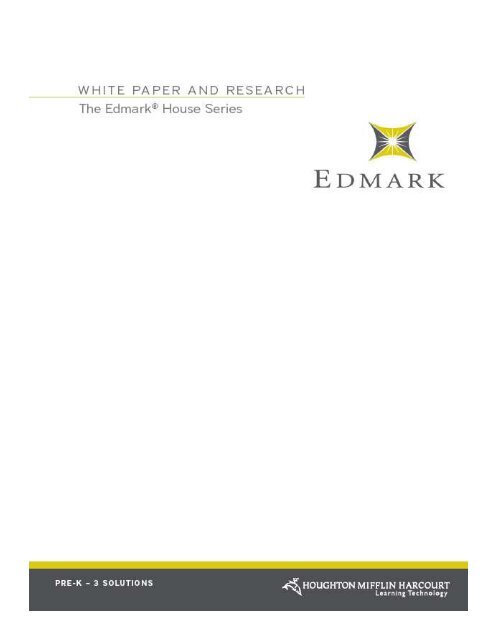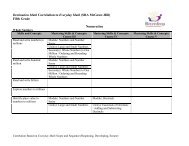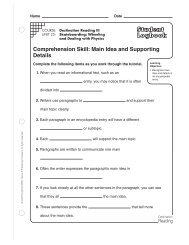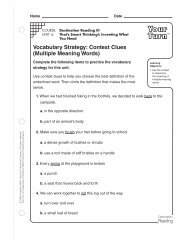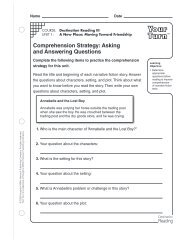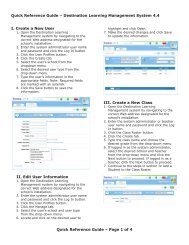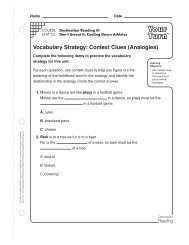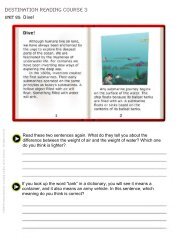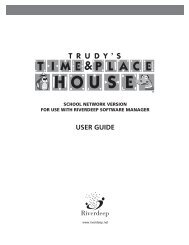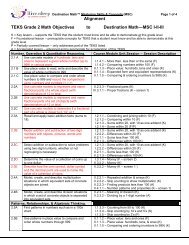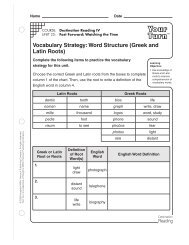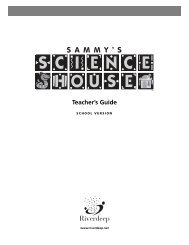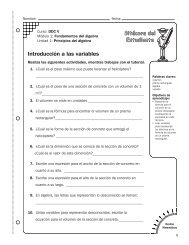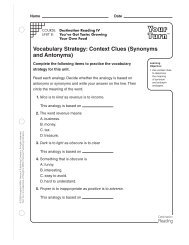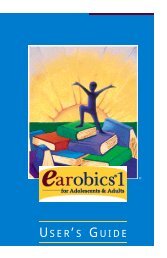Edmark House Series - Houghton Mifflin Harcourt
Edmark House Series - Houghton Mifflin Harcourt
Edmark House Series - Houghton Mifflin Harcourt
Create successful ePaper yourself
Turn your PDF publications into a flip-book with our unique Google optimized e-Paper software.
<strong>Edmark</strong> <strong>House</strong> <strong>Series</strong><br />
Early childhood education is growing across the United States. It is reforming to provide<br />
developmentally appropriate learning activities and experiences for the young child. Technology<br />
is providing a new dimension to this learning experience both for the child and the teacher. It is<br />
helping teachers provide multiple modalities of learning and allowing children to be introduced<br />
to and discover new and exciting things in their world of learning.<br />
The U.S. Department of Education reports that over 90% of children between the ages of 5 and<br />
17 utilize computers in their homes (2004). Technology brings about new avenues of learning,<br />
and challenges in using it correctly to meet the needs of young children. Early childhood<br />
educators must look closely at the impact of technology and the use of it in their classrooms. In<br />
doing so, it is imperative that the use of technology follows the developmental needs of the<br />
young learner. The learning environment should never lose the ability for a child to discover,<br />
explore and have hands-on opportunities independently and with others.<br />
In order to promote best practices in meeting the needs of young children in the early learning<br />
environment, <strong>Houghton</strong> <strong>Mifflin</strong> <strong>Harcourt</strong> Learning Technology (HMHLT) has modeled its<br />
implementation of the <strong>Edmark</strong> ® <strong>House</strong> <strong>Series</strong> with the National Association for the Education of<br />
Young Children (NAEYC). NAEYC and HMHLT are dedicated to the development of young<br />
minds in an appropriate learning environment. NAEYC provides the guidelines to effective<br />
integration and implementation of technology in the early childhood classroom.<br />
NAEYC promotes best practices in effective instruction to impact young learners. In looking at<br />
the digital age in education and the technology trends that are occurring in both homes and<br />
schools, many questions surface about the use of technology in early childhood classrooms.<br />
NAEYC’s position supports the use of technology in the classroom with effective instructional<br />
practices in selection, delivery and monitoring of child interaction with technology.<br />
According to NAEYC, “the early childhood educator has a responsibility to critically examine<br />
the impact of technology on children and be prepared to use technology to benefit children.”<br />
Technology, if selected and used appropriately, will impact the early learner (Shade & Watson,<br />
1990).<br />
<strong>Houghton</strong> <strong>Mifflin</strong> <strong>Harcourt</strong> Learning Technology provides developmentally appropriate<br />
instructional technology solutions for the early learner with the <strong>Edmark</strong> ® <strong>House</strong> <strong>Series</strong>.<br />
Scientifically research-based and interactive engaging learning, the <strong>Edmark</strong> ® <strong>House</strong> <strong>Series</strong> opens<br />
the world of discovery for the young child.<br />
In 2006, NAEYC stated its position on the use of technology in the early childhood classroom.<br />
This position paper detailed the need for educators to utilize 7 principles when implementing<br />
technology. Each program should be of the highest standard as detailed by the position paper.<br />
Instructionally sound and designed for the early learner, the <strong>Edmark</strong> ® <strong>House</strong> <strong>Series</strong> aligns to that<br />
position.<br />
2
The <strong>Edmark</strong> ® <strong>House</strong> <strong>Series</strong> is a comprehensive solution designed by early learning specialists. It<br />
includes interactive software and activities that motivate and engage children to discover new<br />
concepts and explore, while promoting a lifelong love of learning.<br />
The <strong>Edmark</strong> ® <strong>House</strong> <strong>Series</strong> and the NAEYC position on technology in the Early Childhood<br />
Classroom dictates that:<br />
1. Technology must be age appropriate, individually appropriate and culturally<br />
appropriate. (NAEYC 2006)<br />
Designed by early literacy and special needs experts, the <strong>Edmark</strong> ® <strong>House</strong> <strong>Series</strong> allows early<br />
learners to discover reading, math, science, and social studies concepts. Featuring a highly<br />
engaging approach to learning, the program is proven to be effective in engaging children and<br />
individualizing instruction -- building a foundation of skills that last a lifetime. Highly engaging<br />
graphics and interactive discovery learning opportunities align to the developmental needs of<br />
children.<br />
Bailey’s Book <strong>House</strong> ® helps children build the foundation for a lifelong love of reading<br />
through exploration of letters, words, rhyming and creating greeting cards. This exploration<br />
allows children to grow and build early literacy skills. Through playful activities, children can<br />
discover letter names and sounds, letter recognition, word families, describing words, text<br />
relation to contextual and visual clues, positional words, sentence building, and much more.<br />
Activities help children build language concepts and thinking skills they need to communicate<br />
and make sense of the world around them. Discovering the meaning to words is made easy for<br />
the children through exciting games and activities with friends like Edmo and Houndini.<br />
3
Millie’s Math <strong>House</strong> ® opens the young child to a world of discovering mathematics. Young<br />
children have the opportunity to build fundamental math concepts and thinking skills through<br />
interactive activities. These activities support the role of play in early childhood learning, as<br />
children explore numbers, shapes, quantities, patterns, and sequencing. Fun and exciting<br />
activities such as the lesson Paint by Number, allows children to learn to identify their numbers,<br />
then moves seamlessly to skip counting by 2’s and 5’s as the child’s learning level increases..<br />
Sammy’s Science <strong>House</strong> ® introduces young children to important early science and thinking<br />
skills. This course helps young scientists build their understanding of biology, ecology, weather,<br />
and conservation concepts. Having concrete examples to form a connection to the world around<br />
them is part of the development of understanding scientific concepts for the early learner. Going<br />
Green is easy with Sammy and his friends as they recycle compost and learn to clean up familiar<br />
environments such as home and school.<br />
4
Trudy’s Time & Place <strong>House</strong> ® provides early learners with the opportunity to explore and<br />
discover essential social science concepts. Children love activities with Trudy. Young Children<br />
expand their knowledge of the world around them through modules that allow them to visit and<br />
compare cities, towns and the countryside. They can build their own landscape by adding<br />
buildings, roads and train tracks to interactive maps. Children will also learn about people in the<br />
community and what they do. Telling time with The Time Twins is exciting as they use both<br />
digital and analog models to understand standard and modern types of clocks.<br />
5
2. Technology, when used appropriately can enhance a child’s cognitive and social<br />
abilities (NAEYC 2006)<br />
Research and development of the <strong>Edmark</strong> ® <strong>House</strong> <strong>Series</strong> was solely refined and developed by<br />
early childhood experts along with teachers of children with special needs. Children discover<br />
new paths in learning and are provided a wealth of opportunities to practice skills in a nonthreatening<br />
way. Positive, gentle feedback, guidance and natural prompts provide<br />
encouragement to young children. All letters, words and sentences are presented in a meaningful<br />
manner supported by visual and audio cues to promote acquisition. Discovery learning is<br />
encouraged through an intuitive interface that includes both graphical and spoken instruction to<br />
allow pre-readers to be interactive with the programs independently. The <strong>Edmark</strong> <strong>House</strong> <strong>Series</strong> ®<br />
is focused on development of early learning skills for children of all abilities using<br />
developmentally appropriate lessons. As children engage with the content, they are guided<br />
through activities with pictures, words and sounds, while techniques that allow children to follow<br />
along are implemented. Through music and song, children explore the world of language and<br />
develop the foundation for reading.<br />
Pacing<br />
Technology must be easy to use and compliment the teacher’s daily classroom activities and<br />
exploration centers. Teachers can drive the instruction or allow for exploration for the children as<br />
they engage in their <strong>Edmark</strong> Learning Center. Teacher guides and take home materials allow for<br />
learning outside the classroom walls to be effortless.<br />
6
3. Technology that is integrated into the early learning classroom supports a child’s<br />
learning (NAEYC 2006)<br />
The four main titles of the <strong>Edmark</strong> ® <strong>House</strong> <strong>Series</strong> expand the world of learning for the<br />
child. Children can discover science, visit different parts of the world, learn foundational<br />
math skills and even create a Happy Birthday Card as they build their love of reading.<br />
The activities promote guided discovery that is in line to early childhood standards of<br />
instruction.<br />
Many opportunities are provided for children to explore and discover through question<br />
and answer modes allowing for independent or structured learning.<br />
7
Bailey’s Book <strong>House</strong> ®<br />
Builds the foundation for a lifelong love of reading through the exploration of letters,<br />
words, rhyming and sentence building.<br />
Children will discover letter names and sounds, rhyming words, adjectives, how text<br />
relates to contextual and visual cues, positional words, letter recognition, sentence<br />
building and more. Activities develop the foundation for strong word recognition,<br />
comprehension, phonics, phonemic awareness, written expression, vocabulary and word<br />
building. Children gain critical concept and thinking skills that help them to<br />
communicate and interact with the world around them.<br />
Millie’s Math <strong>House</strong> ®<br />
Builds the foundation for a solid understanding of fundamental math concepts and<br />
thinking skills through discovery. Children are given the opportunity to explore numbers,<br />
shapes, quantities, patterns, and sequencing while also using graphs as measurement tools<br />
and the use of numbers to paint. The foundation is established for children to begin to<br />
build critical skills such as numbers, measurement, geometry, computation, quantitative<br />
reasoning and pre-algebra skills.<br />
Sammy’s Science <strong>House</strong> ®<br />
Teaches budding scientists how to observe, analyze and test theories. Children build an<br />
understanding of important early science and thinking skills ranging from biology to<br />
ecology and weather. They will explore topics such as animal characteristics and the<br />
importance of recycling. All children are encouraged to think like a scientist.<br />
8
Trudy’s Time & Place <strong>House</strong> ®<br />
Children are encouraged to explore the world around them. Children visit and compare<br />
cities, towns and countryside- learning about the people in these communities and what<br />
they do. Various activities expose the children to travel virtually exposing them to a<br />
world outside their own.<br />
4. Technology should be available to all students. Equal access should be provided to<br />
students with special needs. (NAEYC 2006)<br />
The ability to provide instructional technology solutions that meet the needs of the diverse<br />
learner are fostered in the <strong>Edmark</strong> ® <strong>House</strong> <strong>Series</strong>. The <strong>Edmark</strong> ® <strong>House</strong> <strong>Series</strong> provides expanded<br />
accessibility options to ensure all children have equal access to learning with built-in universal<br />
access and pacing options which include the ability to select and assign accessibility options by<br />
the child. Closed captioning of all audio controls and screen scaling for larger views is also<br />
available.<br />
<strong>Edmark</strong> ® <strong>House</strong> <strong>Series</strong> provides two accessibility options for children with special needs and<br />
early learners. TouchFree Switch ® is an all-in-one touch switch solution. By placing a video<br />
camera with the switch software, the TouchFree ® Switch allows users to trigger mouse clicks<br />
without applying pressure. TouchWindow ® allows learners to use a computer successfully from<br />
their first experience. Children and teachers naturally point to and touch computer monitors<br />
while using the software.<br />
5. Technology should influence a child’s teaching and development without bias and<br />
promote diversity (NAEYC 2006)<br />
<strong>Edmark</strong> ® <strong>House</strong> <strong>Series</strong> provides children the opportunity to engage and interact with activities<br />
that allow them to explore and discover cultural differences and promote diversity. Nations from<br />
around the world are introduced and the early learner is encouraged to interact with them.<br />
Multiple modalities of learning are supported in the variety of activities surrounding the concepts<br />
introduced. In Trudy’s Time and Place <strong>House</strong>, the activity Culture Festival introduces the early<br />
learner to cultures from around the world. During the practice mode, the children have the<br />
opportunity to discover four different lands: an Asian Country (Japan), a Latin American<br />
Country (Mexico), an African Country (Tanzania), and a European Country (Germany). The<br />
children explore dwellings, traditional attire, local foods, traditional music and more. During<br />
the question and answer mode, the mascot asks the children to go in search of certain items from<br />
around the world, while giving them more clues as they move along. The children then place<br />
these items into a “scrapbook” which they can later print.<br />
9
Trudy’s Time & Place<br />
<strong>House</strong>®<br />
Cultural Festival<br />
6. Teachers and parents should be empowered with appropriate technology<br />
applications for children (NAEYC 2006)<br />
Providing opportunities for learning outside the classroom walls is an important goal of the<br />
program. Each of the <strong>Edmark</strong> ® <strong>House</strong> <strong>Series</strong> programs provide the best in print, curriculum and<br />
together-time activities. These are available under Teacher Resources in the teacher<br />
management area of the program and available to all parents, guardians and caregivers. All<br />
teachers using the program regardless of their location have access to these resources directly<br />
from the system, rather than tracking down a binder that may be misplaced or lost. Teachers can<br />
support classroom learning opportunities for the child by providing parents with developmentally<br />
appropriate learning activities to complete at home.<br />
The <strong>Edmark</strong> <strong>House</strong> series provides additional support for teachers, parents and children through<br />
the activity guides. Teachers may select to send these activities home with children to provide<br />
for additional discovery with parents or utilize them in alignment with class materials during the<br />
school day.<br />
10
Anywhere, anytime access to the <strong>Edmark</strong> ® <strong>House</strong> <strong>Series</strong> puts no limits to the learning and<br />
acquisition of skills that can be provided to children and parents at home. Parents can feel secure<br />
that the content within the software is educational reliable and developmentally appropriate.<br />
7. The use of technology in the early childhood classroom must be supported by a<br />
strong professional development program.<br />
Teachers working in early childhood education need in-depth training and ongoing support to<br />
integrate technology into the classroom. Balancing the hands-on learning with guided<br />
practice by professional development experts is crucial to the developmentally appropriate<br />
integration of technology.<br />
11
<strong>Houghton</strong> <strong>Mifflin</strong> <strong>Harcourt</strong> Learning Technology provides high-quality in-depth professional<br />
development to assist teachers with all of the skills and strategies they will need to support a<br />
best practices model of product implementation. Ongoing support is provided through<br />
professional coaching and mentoring and multiple sharing times to engage and evaluate the<br />
teacher as the learner. These Teacher to Teacher sessions build upon the teacher’s capacity<br />
for learning. Technology is an area of the curriculum, as well as a tool for learning in which<br />
teachers must demonstrate their own capacity for learning (Bredekamp & Rosegrants, 1994,<br />
61).<br />
All the experiences are rooted in the effective principles of professional development,<br />
allowing teachers to utilize teaching techniques that they are familiar with to integrate<br />
technology, maximize the use of technology through parental involvement, map the<br />
technology to the individual needs of the students, and facilitate cooperative learning among<br />
children. (Kearsley & Lynch 1992)<br />
“If you want educational software that is going to reinforce what you’ve<br />
taught and that’s going to make it fun and interactive for your students<br />
and have children learning without even knowing that they are learning,<br />
this is the perfect program for you to choose.”<br />
T e r r y M o o r e<br />
T e c h n o l o g y F a c i l i t a t o r<br />
H a r n e t t P r i m a r y S c h o o l<br />
D u n n , N C<br />
12
References<br />
Bredekamp,S., & T. Rosegrant. 1994. Learning and teaching with technology. In Young<br />
Children: Active learners in a technological age, eds.J.L. Wright &D.D> Shade, 53-61.<br />
Washington, DC: NAEYC<br />
National Association for the Education of Young Children (NAEYC). 2006. National<br />
Association for the Education of Young Children position statement on Technology and<br />
Young Children—Ages 3 through 8. Washington DC. 2008<br />
Shade, D.D., & J.A. Watson. 1990. Computers in early education: Issues put to rest,<br />
theoretical links to sound practice, and the potential contribution of microworlds. Journal<br />
of Educational Computing Research 6 (4): 375-92<br />
US Department of Education (USDOE) 2004. National Education Technology Plan 2004.<br />
Washington DC.<br />
14


